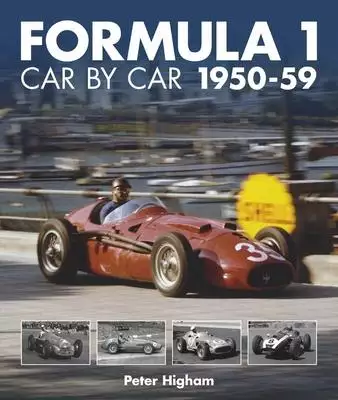Alfa Romeo 車的問題,我們搜遍了碩博士論文和台灣出版的書籍,推薦Higham, Peter寫的 Formula 1: Car by Car: 1950-59 和Rees, Chris的 Alfa Romeo Coupes and Spiders in Detail Since 1945都 可以從中找到所需的評價。
這兩本書分別來自 和所出版 。
國立交通大學 傳播研究所 李秀珠所指導 孫宇萱的 品牌個性與消費者自我概念一致性對於品牌態度之影響-以台灣購物網站為例 (2013),提出Alfa Romeo 車關鍵因素是什麼,來自於品牌個性、自我一致性理論、品牌態度、購買意願、購物網站。
而第二篇論文靜宜大學 管理碩士在職專班 方祥明所指導 陳芝櫻的 生活型態、人格特質、品牌個性與品牌權益間關係之研究:以台灣與中國大陸美髮沙龍業為例 (2012),提出因為有 生活型態、人格特質、生活型態、品牌權益的重點而找出了 Alfa Romeo 車的解答。
Formula 1: Car by Car: 1950-59

為了解決Alfa Romeo 車 的問題,作者Higham, Peter 這樣論述:
The formative years of the 1950s are explored in this fourth installment of Evro's decade-by-decade series covering all Formula 1 cars and teams. When the World Championship was first held in 1950, red Italian cars predominated, from Alfa Romeo, Ferrari and Maserati, and continued to do so for much
of the period. But by the time the decade closed, green British cars were in their ascendancy, first Vanwall and then rear-engined Cooper playing the starring roles, and BRM and Lotus having walk-on parts. As for drivers, one stood out above the others, Argentine Juan Manuel Fangio, becoming World C
hampion five times. Much of the fascination of this era also lies in its numerous privateers and also-rans, all of which receive their due coverage in this complete work. Year-by-year treatment covers each season in fascinating depth, running through the teams -- and their various cars -- in order o
f importance. Alfa Romeo's supercharged 11/2-litre cars dominated the first two years, with titles won by Giuseppe Farina (1950) and Fangio (1951). The new marque of Ferrari steamrollered the opposition in two seasons run to Formula 2 rules (1952-53), Alberto Ascari becoming champion both times, and
the same manufacturer took two more crowns with Fangio (1956) and Mike Hawthorn (1958). Maserati's fabulous 250F, the decade's most significant racing car, propelled Fangio to two more of his five championships (1954 and 1957). German manufacturer Mercedes-Benz stepped briefly into Formula 1 (1954-
55) and won almost everything with Fangio and up-and-coming Stirling Moss. Green finally beat red when the Vanwalls, driven by Moss and Tony Brooks, won the inaugural constructors' title (1958). Then along came Cooper, rear-engine pioneers, to signpost Formula 1's future when Jack Brabham became Wor
ld Champion (1959). Peter Higham works in motor racing as a writer and project manager. For nearly 30 years he worked for Haymarket Consumer Media, publisher of motor racing magazines and websites, and for half of that period he was director of LAT Photographic (now Motorsport Images), the world’s
largest motor racing photo archive. A motor racing enthusiast since watching his first race in 1973, he has written seven books, including the acclaimed International Motor Racing Guide and World Encyclopaedia of Racing Drivers. He has been a columnist for Autosport and Motor Sport and was instrume
ntal in running the prestigious Autosport Awards for over 25 years. He lives in Twickenham, Middlesex.
Alfa Romeo 車進入發燒排行的影片
性能強悍又兼具實用的頂級性能轎跑總是讓車迷們難掩垂涎,想知道德國與義大利作品之間的性格差異,這回就讓我們以浪漫的步伐來一起探索!
#偷泥的賽車紀實器 #PIT挪威特國際有限公司
【BMW M5 Competition 德哥試駕】:
https://youtu.be/Ups-MbRMm54
【BMW X4 M Competition 德哥試駕】:
https://youtu.be/-bvmYn1edAI
【Alfa Romeo Giulia Quadrifoglio 德哥試駕】:
https://youtu.be/QysCJt-Hk9I
【Alfa Romeo Stelvio Quadrifoglio 德哥試駕】:
https://youtu.be/Twj1Jn4JysU
品牌個性與消費者自我概念一致性對於品牌態度之影響-以台灣購物網站為例
為了解決Alfa Romeo 車 的問題,作者孫宇萱 這樣論述:
網路之興起促使網路使用人口快速攀升,成為現代人生活中的一部分,亦同時帶動了網路於商業應用上之發展。快速便利的網路消費行為縮短了現代人購物的時間,增強購物之機動性,造就電子商務市場蓬勃之現狀。本研究根據品牌個性與自我概念一致性理論,探討購物網站展現的品牌個性與消費者自我概念一致性之程度,並檢視一致性程度是否會影響其對於該網站的品牌態度,進而影響消費者的購買意願。本研究採用網路問卷調查法,有效樣本共計 818 份,回收率為 87.2 %。研究結果發現:(1)購物網站之品牌個性確實顯著影響消費者對購物網站之品牌態度。(2)消費者自我概念與其認知的品牌個性之間的一致性程度,部分正向影響消費者對於購物
網站之品牌態度。(3)「有活力的」品牌個性一致性藉由品牌態度此中介機制對購買意願具有顯著正向影響;品牌態度顯著正向影響購買意願。
Alfa Romeo Coupes and Spiders in Detail Since 1945

為了解決Alfa Romeo 車 的問題,作者Rees, Chris 這樣論述:
Alfa Romeo Coupes and Spider In Detail since 1945 tells the full story of Alfa’s two-door cars in the post-war era. It’s all clearly detailed by a true authority on Italian cars, Chris Rees, editor of Auto Italia.
生活型態、人格特質、品牌個性與品牌權益間關係之研究:以台灣與中國大陸美髮沙龍業為例
為了解決Alfa Romeo 車 的問題,作者陳芝櫻 這樣論述:
品牌個性是構成品牌力的重要元素,也是品牌的核心價值,因此塑造品牌個性就成為企業的當務之急。本研究主要是探討不同生活型態與人格特質的消費者在美髮沙龍品牌個性偏好上的差異,以了解不同品牌個性的美髮沙龍的目標顧客特質,其次,探討消費者對美髮沙龍品牌個性感受程度對品牌權益的影響,以做為企業在擬定品牌個性策略時的參考依據。本研究是以台灣與中國大陸地區的美髮沙龍消費者為研究對象,並採問卷做為研究資料蒐集之工具,以驗證本研究所提出的三項研究假設。經過四週後,總計回收376份有效問卷,其中在台灣共計有284份,中國大陸有92份。隨後,進行資料分析,並得到以下結論:一、不同生活型態的消費者在品牌個性的偏好上會
有顯著的差異存在。二、不同人格特質的消費者在品牌個性的偏好上會有顯著的差異存在。三、消費者對品牌個性的感受程度會對該品牌的品牌權益產生顯著的正向影響。最後,除了提出本研究結論於理論與實務上的意涵外,也敘述本研究的限制,並對未來後續相關研究提出建議。